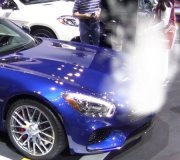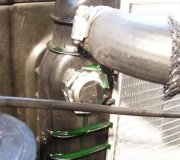On my way to work tonight, my temperature gauge started rising gradually and then white smoke (smelled kinda like chlorine, not too strong a smell) billowed out of my hood. Pulled into work about 1 minute later and turned the car off. Opened the hood and looks like the smoke was coming from around the radiator cap, near where the hose from the coolant connects to it. I have no money to have the car looked at, at least for like 2 weeks. I can't leave the car at work-so I have to drive it home (7 miles). Coolant tank is filled normally (about half), no fluids under car. I had the radiator and thermostat replaced 5 months ago due to overheating/smoking/bad radiator-since then, the temperature has normally been all the way at the bottom of the gauge, cool, near the blue line, until about 2 weeks ago. Started gradually rising in temperature in those 2 weeks, til it got to about the halfway temperature line every day after driving for a few minutes. It gets hotter when I stop at lights, etc. I had noticed for the past few days that after turning off the engine and stepping out of my car, a hissing noise could be heard coming from the front right bumper area, around the coolant tank. Noise dissipates after a few minutes. I drive for only about 30 minutes a day, 5 days a week, don't drive fast or accelerate recklessly (not that I can, because the pickup is really clunky on this car). Help! There's an autozone right next to my work that I could pick up parts from if need be.
-when I bought the car 6 months ago, the owner told me it leaks oil, and you have to have a 5-quart of oil in the trunk for if it decides to get low
-when shifting gears (it's automatic) the engine stutters, car shakes, sounds like it will conk out-never does. I just shift slowly to try to be easy on it
-when changing my oil 7 days ago, the guy who did it said my lower radiator hose was sucking in air, he couldn't figure out why. This is after the heat started rising 2 weeks ago
SPONSORED LINKS
Saturday, February 26th, 2011 AT 9:02 AM



